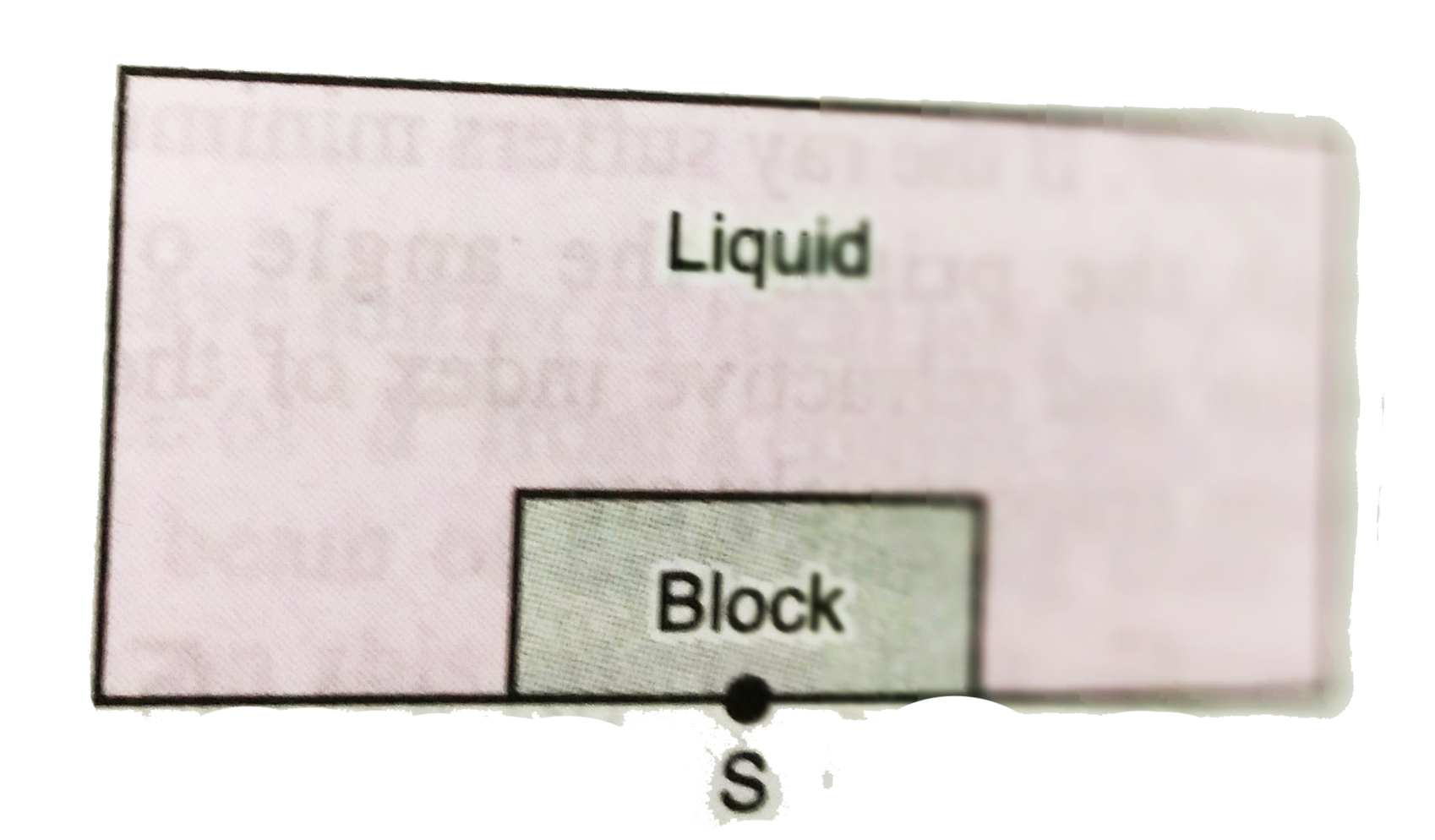If a point source is placed at a depth h in a liquid of refractive index 43 . Find percentage of energy of light that escapes from liquid. (assuming 100% transmission of emerging light)
15%
17%
21%
34%
The correct Answer is:B
To solve the problem of finding the percentage of energy of light that escapes from a liquid with a refractive index of 43, we will follow these steps:
Step 1: Understanding the Problem
We have a point source of light placed at a depth h in a liquid with a refractive index n=43. We need to determine the percentage of light energy that escapes from the liquid.
Step 2: Apply Snell's Law
Using Snell's Law, we can find the angle of incidence i at which light emerges from the liquid to air. Snell's law states:
n1sini=n2sinr
Here, n1=43 (for the liquid), n2=1 (for air), and r is the angle of refraction. Since we are interested in the critical angle for total internal reflection (TIR), we can set r=90∘:
43sini=1⋅sin90∘
This simplifies to:
sini=34
Step 3: Calculate cosi
Using the identity sin2i+cos2i=1:
cosi=√1−sin2i=√1−(34)2=√1−916=√716=√74
Step 4: Determine the Solid Angle
The solid angle Ω subtended at the apex of the point source can be calculated using the formula:
Ω=2π(1−cosβ)
where β is the angle of emergence. In our case, cosβ=cosi=√74:
Ω=2π(1−√74)
Step 5: Calculate the Total Solid Angle
The total solid angle in three-dimensional space is 4π. The percentage of light escaping can be calculated by taking the ratio of the solid angle that escapes to the total solid angle:
Percentage of light escaping=Ω4π×100=2π(1−√74)4π×100
This simplifies to:
Percentage of light escaping=1−√742×100
Step 6: Final Calculation
Substituting √7≈2.64575:
Percentage of light escaping=1−2.6457542×100≈1−0.66143752×100≈0.33856252×100≈16.93%
Rounding this gives approximately 17%.
Conclusion
The percentage of energy of light that escapes from the liquid is approximately 17%.
---
We have a point source of light placed at a depth h in a liquid with a refractive index n=43. We need to determine the percentage of light energy that escapes from the liquid.
Using Snell's Law, we can find the angle of incidence i at which light emerges from the liquid to air. Snell's law states:
n1sini=n2sinr
Here, n1=43 (for the liquid), n2=1 (for air), and r is the angle of refraction. Since we are interested in the critical angle for total internal reflection (TIR), we can set r=90∘:
43sini=1⋅sin90∘
This simplifies to:
sini=34
Using the identity sin2i+cos2i=1:
cosi=√1−sin2i=√1−(34)2=√1−916=√716=√74
The solid angle Ω subtended at the apex of the point source can be calculated using the formula:
Ω=2π(1−cosβ)
where β is the angle of emergence. In our case, cosβ=cosi=√74:
Ω=2π(1−√74)
The total solid angle in three-dimensional space is 4π. The percentage of light escaping can be calculated by taking the ratio of the solid angle that escapes to the total solid angle:
Percentage of light escaping=Ω4π×100=2π(1−√74)4π×100
This simplifies to:
Percentage of light escaping=1−√742×100
Substituting √7≈2.64575:
Percentage of light escaping=1−2.6457542×100≈1−0.66143752×100≈0.33856252×100≈16.93%
Rounding this gives approximately 17%.
The percentage of energy of light that escapes from the liquid is approximately 17%.
Topper's Solved these Questions
Similar Questions
Knowledge Check
A point source of light is placed at a depth of h below the surface of water of refractive index μ. A floating opaque disc is placed on the surface of water so that light from the source is not visible from the surface. The minimum diameter of the disc is
A2h(μ2−1)1/2B2h(μ2−1)1/2Ch2(μ2−1)1/2Dh(μ2−1)1/2
A point source of light is placed at a depth h=0.5 m below the surface of a liquid (μ=54) , Then , the fraction of light energy that escape directly from the liquid surface is
View SolutionA point source of light S is placed at the bottom of a vessel containg a liquid of refractive index 5/3. A person is viewing the source from above the surface. There is an opaque disc of radius 1cm floating on the surface. The centre of the disc lies vertically above the source S. The liquid from the vessel is gradually drained out through a tap. What is the maximum height of the liquid for which the source cannot at all be seen from above?
View SolutionA disc is placed on the surface of pond filled with liquid of refractive index 53. A source of light is placed 4m below the surface of liquid. Calculate the minimum area of the disc so that light does not come out of liquid.
View SolutionA point source of light is placed at a distance hbelow the surface of a large deep lake.What is the percentage of light energy that escapes directly form the water surface if μof the water=4/3?(neglet partial reflection)
View SolutionA point source is placed at a depth h below the surface of water (refractive index = mu). (a) Show that light escapes through a circular area on the water surface with its centre directly above the point source. (b) Find the angle subtended by a radius of the area on the source.
View SolutionA light ray of frequency v and wavelength λ enters a liquid of refractive index 3/2. The ray travels in the liquid with
View SolutionA point source S is placed at the bottom of a transparent block of height 10mm and refractive index 2.72. It is immersed in a lower refractive index liquid as shwon in Fig. I tis found that the light emerging from the block to the liquid forms a circular bright spot of diameter 11.54mm on the top of the block. The refractive index of the liquid is

View Solution
